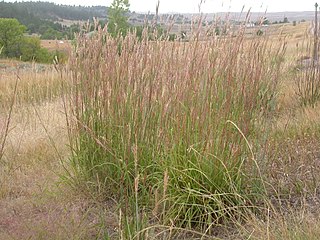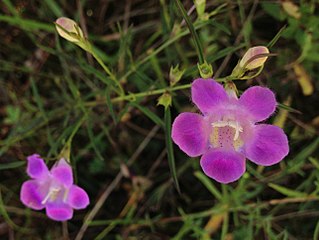
Paulownia tomentosa, common names princess tree, empress tree, or foxglove-tree, is a deciduous hardwood tree in the family Paulowniaceae, native to central and eastern China and the Korean Peninsula. It is an extremely fast-growing tree with seeds that disperse readily and is considered an invasive exotic species in North America that has undergone naturalisation in large areas of the Eastern US, even though it might be able to successfully get established through seeds only under ideal conditions. P. tomentosa has also been introduced to Western and Central Europe, and is establishing itself as a naturalised species there as well.

Digitalis purpurea, the foxglove or common foxglove, is a toxic species of flowering plant in the plantain family Plantaginaceae, native to and widespread throughout most of temperate Europe. It has also naturalized in parts of North America, as well as some other temperate regions. The plant is a popular garden subject, with many cultivars available. It is the original source of the heart medicine digoxin. This biennial plant grows as a rosette of leaves in the first year after sowing, before flowering and then dying in the second year. It generally produces enough seeds so that new plants will continue to grow in a garden setting.

Andropogon gerardi, commonly known as big bluestem, is a species of tall grass native to much of the Great Plains and grassland regions of central and eastern North America. It is also known as tall bluestem, bluejoint, and turkeyfoot.

Claytonia virginica, the Virginia springbeauty, eastern spring beauty, grass-flowernarrowleaf springbeauty or fairy spud, is an herbaceous perennial plant in the family Montiaceae. Its native range is eastern North America. Its scientific name honors Colonial Virginian botanist John Clayton (1694–1773).

Agalinis acuta is an annual hemiparasitic plant native to Maryland, Massachusetts, Rhode Island, Connecticut, and Long Island, New York. Common names include sandplain gerardia and sandplain false foxglove. It is one of about 70 species that comprise genus Agalinis. It currently resides within the family Orobanchaceae, but historically was aligned with members of the Scrophulariaceae. This was one of several re-alignments that were the consequence of the disintegration of the Scrophulariaceae as the result of conclusions based on molecular phylogeny data from the chloroplast genome. While historically regarded as a separate species, molecular phylogenetic data indicates that Agalinis acuta should be consolidated as part of the species Agalinis decemloba.

Solidago rugosa, commonly called the wrinkleleaf goldenrod or rough-stemmed goldenrod, is a species of flowering plant in the family Asteraceae. It is native to North America, where it is widespread across eastern and central Canada and the eastern and central United States. It is usually found in wet to mesic habitats.

Lupinus rivularis is a species of lupine known by the common name riverbank lupine native to North America. It is also commonly known as river lupine, streambank lupine, and stream lupine.

Pityopsis ruthii is a rare species of flowering plant in the family Asteraceae known by the common name Ruth's golden aster. It is endemic to the US state of Tennessee, where it is known only from Polk County. It is threatened by the modification of its habitat. It is a federally listed endangered species.

Agalinis auriculata is a species of flowering plant in the family Orobanchaceae known as earleaf false foxglove, auriculate false foxglove, and earleaf gerardia. It is endemic to the United States, where it occurs from New Jersey west to Minnesota and throughout most southern states.

Agalinis skinneriana is a species of flowering plant in the family Orobanchaceae known by the common names Skinner's gerardia, Skinner's false foxglove and pale false foxglove. It is native to North America, where it occurs in Ontario south to Missouri and Louisiana.

Symphyotrichum georgianum is a rare species of flowering plant in the Asteraceae, the aster family. Its common name is Georgia aster. It is native to the southeastern United States where it is known from Alabama, Florida, Georgia, North Carolina, and South Carolina. As of 2013, it may be extirpated from the state of Florida.

Agalinis purpurea is an annual forb native to the eastern United States and Canada, which produces purple flowers in late summer or early fall.

Agalinis tenuifolia, known by the common names common gerardia, slender false foxglove or common false foxglove, is an annual forb native to the eastern and southwestern United States, and Canada, which produces purple flowers in late summer or early fall.

Lespedeza virginica, known as slender bush clover or slender lespedeza, is a species of flowering plant native to much of the United States, as well as Ontario, Canada, and Nuevo León, Mexico. It is a member of the bean family, Fabaceae.

Hieracium scabrum, commonly known as rough hawkweed or sticky hawkweed, is a North American plant species in the tribe Cichorieae within the family Asteraceae. It is native to the eastern and central United States and Canada.
The flora of Door County, Wisconsin comprise a variety of plant species. Geobotanically, Door County belongs to the North American Atlantic Region.















